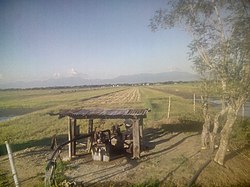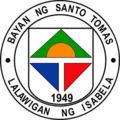Santo Tomas, Isabela
 From Wikipedia - Reading time: 11 min
From Wikipedia - Reading time: 11 min
Santo Tomas | |
|---|---|
| Municipality of Santo Tomas | |
 | |
 Map of Isabela with Santo Tomas highlighted | |
| Coordinates: 17°24′N 121°46′E / 17.4°N 121.77°E | |
| Country | Philippines |
| Region | Cagayan Valley |
| Province | Isabela |
| District | 1st district |
| Founded | July 1, 1949[1] |
| Barangays | 27 (see Barangays) |
| Government | |
| • Type | Sangguniang Bayan |
| • Mayor | Antonio M. Talaue, Sr. |
| • Vice Mayor | Amado Talaue |
| • Representative | Antonio T. Albano |
| • Electorate | 17,760 voters (2025) |
| Area | |
• Total | 60.70 km2 (23.44 sq mi) |
| Elevation | 35 m (115 ft) |
| Highest elevation | 66 m (217 ft) |
| Lowest elevation | 16 m (52 ft) |
| Population (2020 census)[5] | |
• Total | 24,528 |
| • Density | 400/km2 (1,000/sq mi) |
| • Households | 5,578 |
| Economy | |
| • Income class | 4th municipal income class |
| • Poverty incidence | 17.36 |
| • Revenue | ₱ 184.2 million (2022) |
| • Assets | ₱ 173.6 million (2022) |
| • Expenditure | ₱ 156.9 million (2022) |
| • Liabilities | ₱ 126.8 million (2022) |
| Service provider | |
| • Electricity | Isabela 2 Electric Cooperative (ISELCO 2) |
| Time zone | UTC+8 (PST) |
| ZIP code | 3327 |
| PSGC | |
| IDD : area code | +63 (0)78 |
| Native languages | Ibanag Ilocano Tagalog |
Santo Tomas, officially the Municipality of Santo Tomas (Ibanag: Ili na Santo Tomás; Ilocano: Ili ti Santo Tomás; Tagalog: Bayan ng Santo Tomás), is a municipality in the province of Isabela, Philippines. According to the 2020 census, it has a population of 24,528 people.[5]
History
[edit]The municipality was established in 1949 from several barrios of Cabagan.[7]
In 1952, Santo Tomas lost two barrios when the barrios of Abut and Minagbag were transferred to the newly created town of Mallig.[8] In 1961, those barrios were transferred to the newly created municipality of Quezon.[9]
Geography
[edit]Santo Tomas is a landlocked municipality situated in the northern portion of the province of Isabela. It is bounded to the west by Quezon, to the south by Delfin Albano, to the southeast by Tumauini, to the north and northeast by Cabagan and the Cagayan River.
Santo Tomas is situated 45.06 kilometres (28.00 mi) from the provincial capital Ilagan, and 473.98 kilometres (294.52 mi) from the country's capital city of Manila.
Barangays
[edit]Santo Tomas is politically subdivided into 27 barangays. [10] Each barangay consists of puroks while some have sitios.
- Ammugauan
- Antagan
- Bagabag
- Bagutari
- Balelleng
- Barumbong
- Biga Occidental
- Biga Oriental
- Bubug
- Bolinao-Culalabo
- Calanigan Norte
- Calanigan Sur
- Calinaoan Centro
- Calinaoan Malasin
- Calinaoan Norte
- Cañogan Abajo Norte
- Cañogan Abajo Sur
- Cañogan Alto
- Centro
- Colunguan
- Malapagay
- San Rafael Abajo
- San Rafael Alto
- San Roque
- San Vicente
- Uauang-Tuliao
- Uauang-Galicia
Uauang-Galicia is now the population is 0 according in 2010 Census.
Climate
[edit]| Climate data for Santo Tomas, Isabela | |||||||||||||
|---|---|---|---|---|---|---|---|---|---|---|---|---|---|
| Month | Jan | Feb | Mar | Apr | May | Jun | Jul | Aug | Sep | Oct | Nov | Dec | Year |
| Mean daily maximum °C (°F) | 29 (84) |
30 (86) |
32 (90) |
35 (95) |
35 (95) |
35 (95) |
34 (93) |
33 (91) |
32 (90) |
31 (88) |
30 (86) |
28 (82) |
32 (90) |
| Mean daily minimum °C (°F) | 19 (66) |
20 (68) |
21 (70) |
23 (73) |
23 (73) |
24 (75) |
23 (73) |
23 (73) |
23 (73) |
22 (72) |
21 (70) |
20 (68) |
22 (71) |
| Average precipitation mm (inches) | 31.2 (1.23) |
23 (0.9) |
27.7 (1.09) |
28.1 (1.11) |
113.5 (4.47) |
141.4 (5.57) |
176.4 (6.94) |
236.6 (9.31) |
224.9 (8.85) |
247.7 (9.75) |
222.9 (8.78) |
178 (7.0) |
1,651.4 (65) |
| Average rainy days | 10 | 6 | 5 | 5 | 13 | 12 | 15 | 15 | 15 | 17 | 16 | 15 | 144 |
| Source: World Weather Online (modeled/calculated data, not measured locally)[11] | |||||||||||||
Demographics
[edit]
|
| ||||||||||||||||||||||||||||||||||||||||||
| Source: Philippine Statistics Authority[12][13][14][15] | |||||||||||||||||||||||||||||||||||||||||||
In the 2020 census, the population of Santo Tomas, Isabela, was 24,528 people,[5] with a density of 400 inhabitants per square kilometre or 1,000 inhabitants per square mile.
Economy
[edit]Poverty incidence of Santo Tomas
10
20
30
40
50
2000
46.00 2003
30.78 2006
23.50 2009
18.46 2012
23.38 2015
21.17 2018
22.68 2021
17.36 Source: Philippine Statistics Authority[16][17][18][19][20][21][22][23] |
Farming is its primary source of income. The most widespread plantations were rice, corn and tobacco farms. Locals also raise livestock for extra income.
Government
[edit]Local government
[edit]As a municipality in the Province of Isabela, government officials at the provincial and municipal levels are voted by the town. The provincial government has political jurisdiction over most local transactions of the municipal government.
The Municipality of Santo Tomas is governed by a mayor, designated as its local chief executive, and by a municipal council as its legislative body in accordance with the Local Government Code. The mayor, vice mayor, and the municipal councilors are elected directly in polls held every three years.
Barangays are also headed by elected officials: Barangay Captain, Barangay Council, whose members are called Barangay Councilors. The barangays have SK federation which represents the barangay, headed by SK chairperson and whose members are called SK councilors. All officials are also elected every three years.
Elected officials
[edit]| Position | Name |
|---|---|
| District Representative | Antonio T. Albano |
| Municipal Mayor | Antonio M. Talaue |
| Municipal Vice-Mayor | Amado Talaue |
| Municipal Councilors | Rona Lulu R. Talaue |
| Eduardo T. Pua, Jr. | |
| Jose Amado S. Talaue | |
| Armando B. Lopez | |
| Eduardo S. Talaue, Jr. | |
| Jesus Canceran | |
| Marirose Angolluan | |
| Sonny P. Tallion |
Congress representation
[edit]Santo Tomas, belonging to the first legislative district of the province of Isabela, currently represented by Hon. Antonio T. Albano.[25]
Education
[edit]The Schools Division of Isabela governs the town's public education system.[26] The division office is a field office of the DepEd in Cagayan Valley region.[27] The Sto. Tomas Schools District Office governs the public and private elementary and high schools throughout the municipality.[28]
Primary and elementary schools
[edit]- Ammugauan Primary School
- Antagan Primary School
- Bagabag Primary School
- Bagutari Elementary School
- Balelleng Elementary School
- Barumbung Elementary School
- Bubug Elementary School
- Calanigan Elementary School
- Calinaoan Elementary School
- Cañogan Elementary School
- Colunguan Elementary School
- Malapagay Elementary School
- San Rafael Abajo Primary School
- San Rafael Alto Elementary School
- San Roque Elementary School
- Sto. Tomas Baptist Christian School
- Sto. Tomas Central School
Secondary schools
[edit]- Biga Integrated School
- Calanigan National High School
- Northern Isabela Academy
- San Vicente Integrated School
- Santo Tomas National High School
References
[edit]- ^ "Santo Tomas Executiv Summary 2016" (PDF). Commission on Audit - coa.gov.ph. Retrieved June 25, 2024.
- ^ Municipality of Santo Tomas | (DILG)
- ^ "2015 Census of Population, Report No. 3 – Population, Land Area, and Population Density" (PDF). Philippine Statistics Authority. Quezon City, Philippines. August 2016. ISSN 0117-1453. Archived (PDF) from the original on May 25, 2021. Retrieved July 16, 2021.
- ^ https://www.philatlas.com/luzon/r02/isabela/santo-tomas.html.
{{cite web}}: Missing or empty|title=(help) - ^ a b c Census of Population (2020). "Region II (Cagayan Valley)". Total Population by Province, City, Municipality and Barangay. Philippine Statistics Authority. Retrieved July 8, 2021.
- ^ "PSA Releases the 2021 City and Municipal Level Poverty Estimates". Philippine Statistics Authority. April 2, 2024. Retrieved April 28, 2024.
- ^ "Executive Order No. 199, s. 1949". Official Gazette of the Republic of the Philippines. Retrieved March 30, 2024.
- ^ "An Act Creating the Municipality of Mallig in the Province of Isabela". LawPH.com. Retrieved April 9, 2011.
- ^ "An Act Creating the Municipality of Quezon in the Province of Isabela". LawPH.com. Retrieved December 6, 2014.
- ^ "Province:". PSGC Interactive. Quezon City, Philippines: Philippine Statistics Authority. Retrieved November 12, 2016.
- ^ "Santo Tomas, Isabela: Average Temperatures and Rainfall". World Weather Online. Retrieved October 31, 2015.
- ^ Census of Population (2015). "Region II (Cagayan Valley)". Total Population by Province, City, Municipality and Barangay. Philippine Statistics Authority. Retrieved June 20, 2016.
- ^ Census of Population and Housing (2010). "Region II (Cagayan Valley)" (PDF). Total Population by Province, City, Municipality and Barangay. National Statistics Office. Retrieved June 29, 2016.
- ^ Censuses of Population (1903–2007). "Region II (Cagayan Valley)". Table 1. Population Enumerated in Various Censuses by Province/Highly Urbanized City: 1903 to 2007. National Statistics Office.
- ^ "Province of". Municipality Population Data. Local Water Utilities Administration Research Division. Retrieved December 17, 2016.
- ^ "Poverty incidence (PI):". Philippine Statistics Authority. Retrieved December 28, 2020.
- ^ "Estimation of Local Poverty in the Philippines" (PDF). Philippine Statistics Authority. November 29, 2005.
- ^ "2003 City and Municipal Level Poverty Estimates" (PDF). Philippine Statistics Authority. March 23, 2009.
- ^ "City and Municipal Level Poverty Estimates; 2006 and 2009" (PDF). Philippine Statistics Authority. August 3, 2012.
- ^ "2012 Municipal and City Level Poverty Estimates" (PDF). Philippine Statistics Authority. May 31, 2016.
- ^ "Municipal and City Level Small Area Poverty Estimates; 2009, 2012 and 2015". Philippine Statistics Authority. July 10, 2019.
- ^ "PSA Releases the 2018 Municipal and City Level Poverty Estimates". Philippine Statistics Authority. December 15, 2021. Retrieved January 22, 2022.
- ^ "PSA Releases the 2021 City and Municipal Level Poverty Estimates". Philippine Statistics Authority. April 2, 2024. Retrieved April 28, 2024.
- ^ "Santo Tomas, Isabela Election Results 2022". Rappler PH. ph.rappler.com. Retrieved May 13, 2022.
- ^ "House of Representatives: 19th Congress". Official Website of the House of Representatives PH. congress.gov.ph. Retrieved May 15, 2022.
- ^ "HISTORY OF DEPED-ISABELA". DepED Isabela | The official website of DepED Schools Division of Isabela. Retrieved March 13, 2022.
- ^ "DEPED REGIONAL OFFICE NO. 02". DepED RO2 | The official website of DepED Regional Office No. 02.
- ^ "Masterlist of Schools" (PDF). Department of Education. January 15, 2025. Retrieved April 11, 2025.
External links
[edit]- Municipal Profile at the National Competitiveness Council of the Philippines Archived July 2, 2017, at the Wayback Machine
- Santo Tomas at the Isabela Government Website
- Local Governance Performance Management System Archived October 10, 2016, at the Wayback Machine
- Philippine Standard Geographic Code
- Philippine Census Information
- Municipality of Santo Tomas
 KSF
KSF


